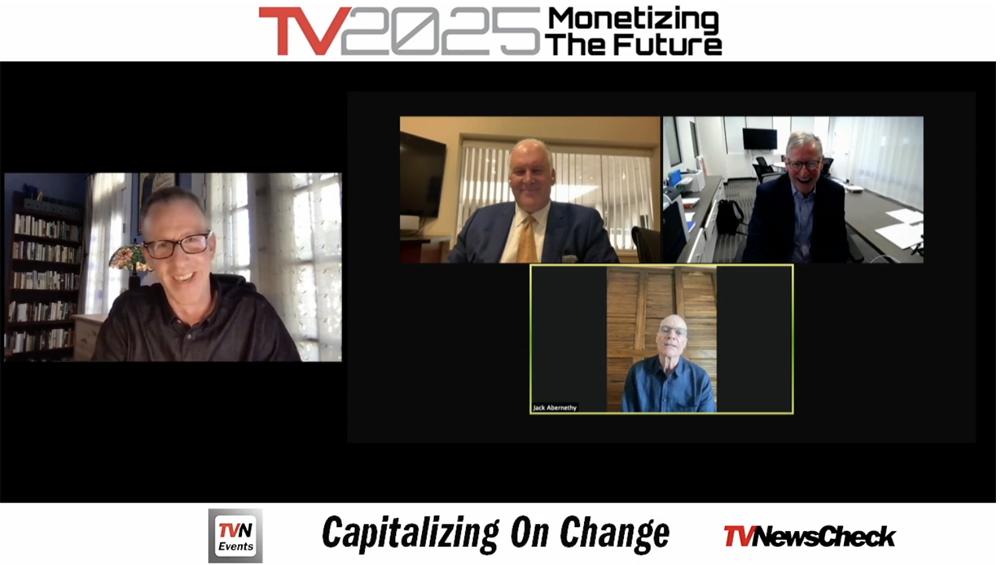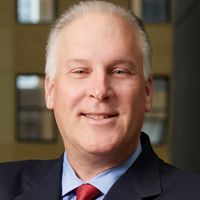
Station Group Chiefs: There’s Common Cause For Broadcast And Cable

Station groups and cable operators could work more closely together on common causes they have rather than constantly being at odds with one another, according to three top local TV executives.
Retransmission rates are not in line with the audiences delivered, but if opposing sides work together, it could help everyone’s businesses, the leaders said during the Station Group Leaders on the State of the Industry panel at TVNewsCheck’s virtual TV2025 conference last week.
Top executives from Fox Television Stations, Gray Television and Hearst Television weighed in on a range of pressing industry issues from streaming to the new NFL contracts, Wall Street’s estimation of the industry to M&A activity, and even the ongoing viability of four major broadcast networks, as well as the depth of their commitment to diversity, equity and inclusion.

Jordan Wertlieb
Retransmission still has “headroom” for growth, said Jordan Wertlieb, president of Hearst Television. “We have yet to see rates commensurate with the audiences that broadcasters bring to the ecosystem,” he said.
Pat LaPlatney, president and co-CEO of Gray Television, agreed that the rates paid to broadcasters “don’t square up” with the “extraordinary” numbers local broadcasters deliver.
But while seemingly “constantly at odds,” Fox Television Stations CEO Jack Abernethy said broadcasters and cable operators may yet find more common ground. For example, he said, broadcasters and union partners may often be “at odds over work rules and such,” but that both wanted safety for employees during COVID, so they were able to work together to achieve that goal.
“We don’t often sit down with our cable partners and say, ‘Hey, how do we do this?’” he said. Instead, “we beat each other up in the press.”
The group leaders also spoke to streaming’s increasing importance for their business.
Just last week, Hearst launched its group of Very Local streaming channels, which offer locally generated programming as well as content made available by magazine partners such as Delish and Esquire in order to offer a “robust” library, Wertlieb said.
He noted it’s pivotal to make a strong first impression with potential streaming viewers. “In this space, you don’t get sampled more than once.”
Fox offers LiveNOW, is launching Fox Weather in October and has another niche offering in the works, Abernethy said.
Based on experiences from cable and the web, “it’s niche services that are going to do well” with streaming audiences, he said. “We have to go after the consumer and give them what they want.”
And some of that content is football. The National Football League has signed 10-year contracts, effective in 2023, with the major broadcasters for the right to show games either over the air or via streaming services.
The new batch of contracts means a loss of exclusivity during games, LaPlatney noted, as, for instance, NFL games won’t just be available on NBC affiliates but also on NBC’s Peacock streaming service.

Jack Abernethy
“Is it ideal? No, but it’s something we’re all going to be dealing with,” he said.
Station groups are also dealing with fluctuating spot advertising markets.
Wertlieb said he believes the shortage of microchips will probably keep the auto ad market from rebounding until next year.
Abernethy suggested the rebound may take even longer, but that it could coincide with the increase in the political cycle.
“If so, it’s going to be good,” he said.
LaPlatney said home improvement and health advertising is “helping fill that auto void.”
Additionally, sports gambling, depending on the locale, may bring in money for stations.
“Betting is such a great category,” Abernethy said.
But even when advertising dollars are rebounding from their pandemic lows, sometimes Wall Street has “misunderstandings” about broadcast stock.
“Any rationality in the stock market … is just not there anymore,” Abernethy said. Wall Street doesn’t “get the fact that this past year, local news has informed the public, has calmed down the public, has served the public in a difficult and scary time.”

Pat LaPlatney
LaPlatney said in some ways Wall Street “undervalues the strength of local — and local news in general” — whether over the air or via other platforms.
Numbers may have spiked and dropped, he said, “but they are still above where they were.”
Meanwhile, as broadcast’s M&A front has once more heated up with the imminent prospect of a Tegna sale, the executives offered their vantage points on where their own groups stood.
“We’re a buyer for the right assets,” Wertlieb said.
LaPlatney: “We’re plenty busy now with what we’ve announced.”
Abernethy said there are no immediate M&A plans but called the idea that groups getting bigger is “somehow bad” a ridiculous one. Larger station groups have more resources, he said. “It doesn’t mean fewer voices, it means more voices and stronger voices.”
Asked if the TV landscape can sustain four major networks for the next three to five years, Abernethy was optimistic they all can remain competitive over the near-term.
“We’re good for five years,” he said, citing recent the NFL contracts. On the other hand, he said, 15 years could be a different story.
The station group leaders also affirmed that they’ve advanced their efforts at diversity, inclusion and equality.
“We are hiring diverse managers at every level,” LaPlatney said. “Diversity is a good thing. It makes you stronger.”
Abernethy and Wertlieb both said their groups have worked with The Emma Bowen Foundation to bring in diverse personnel.
“If you put the money behind the programs like The Emma Bowen Foundation, the T. Howard Foundation, you’re going to see change,” Abernethy said.
To watch the video of this session, click here.
For more TV2025 2021 stories, click here.


































Comments (3)
TheVoiceofTruth says:
September 28, 2021 at 9:58 am
Always look forward to the comments of a guy who never worked a day in a television station: Pat Laplatney.
AIMTV says:
September 28, 2021 at 10:45 am
Broadcasting is too reliant on revenue from a near-dead industry—an industry they should just let die.
For consumers, cable is no longer necessary as a delivery device, but certainly, as programming, it’s a complete wasteland. Most people only watch a handful of channels, and most cable channels have the tiniest of audiences. Yet they exist because people are forced to pay for channels they don’t watch, and marketing agencies have fooled their clients into buying in bulk. Travel targeted advertisers still advertise on Travel Channel (or is it TRVL this week?), even though it’s been “travel” in name only for some time now. Paranormal advertisers should be flocking there instead, though I’m not sure what a paranormal advertiser would be.
The point is, viewer (and advertiser) interests are no longer served on cable outlets (MTV = no music, Historic Channel = no history, Travel Channel = No Travel, etc.)… This refrain has been repeating for lo many years now.
I have no personal ax to grind with cable as a delivery device. I just don’t like the industry’s lack of creativity and “me too” exploitive approach to programming that throws out new branding direction every few months and makes dozens of channels all look the same.
Their “leaders” look like simple-minded lemmings with seemingly no commitment to a specific, clearly defined vision, no stability of purpose, no moral or ethical compass to guide them in their decision-making. The industry venerates the executives who helped kill it and treat them as heroes when they retire. They should have instead tossed them out on their rears years ago.
An entire industry, who may be right on occasion (what is it about blind pigs?), but is wrong an awful lot. And they work in lockstep… shamelessly copying each others’ failures while pretending individual success.
In a desperate attempt to remain relevant, their “news” channels are now nothing more than partisan and often misguided opinion shows with a horrific track record of journalistic integrity. Their political punditry obsessions and “do anything for ratings” mentality have literally killed people during a global pandemic and threatened the most powerful nation in the world’s democracy.
Cable’s continued missteps, lack of credibility, and source of consumer scorn are broadcasting opportunities. Instead of focusing on “can we all just get along,” I say broadcasters should prey upon cable’s many weaknesses, squash the entire industry and put it and the American people out of this fumbling, bumbling, dinosaur’s misery.
But then I guess it’d be no more retransmission money, huh?
Michael N. Ruggiero says:
September 29, 2021 at 11:35 am
After 40 years of serving the broadcast TV industry. The obvious emerges. ATV Broadcast’s mission statement is to bring broadcasters and cable closer together. Mike Ruggiero Founder and Chairman of ATV Broadcast, Fishers Indiana 317.514.7537 [email protected]